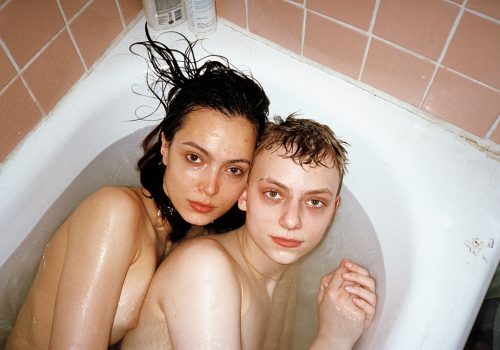Marie Tomanova’s debut monograph Young American celebrates an idea of an “America” still rife with dreams and possibilities, hope and freedom. As a Czech immigrant struggling in a new environment to belong, to come to terms with her repressive past and her uncertain future, the portraits taken between 2015 and 2018 in New York City visualize an America in which individuality is valued as uniqueness and not judged as a lack of sameness.
Young American resonates with directness, presence, and the ability to see deeply an individual with whom we can somehow identify. It is about optimism, youth, and the connection between people—the humanness that is essential to us all. To look deeply at Tomanova’s portraits and to see them looking deeply back at you is the heart of this work. Young American asserts the hope for a better future as an antidote to an oppressive and intolerant social and political situation in the United States and, perhaps, globally. Young American points not only to youth empowerment and the potent voice and presence that has emerged with it, but also to the welcome disintegration of any sort of set idea about identity. One could contextualize Tomanova’s Young American in the increasingly important and powerful voice of youth culture that is in the process of vitally reshaping gender, society, culture, and igniting a much-needed ideological revolution.
As photographer Ryan McGinley writes in his introduction to Young American, “This is a future free of gender binaries and stale old definitions of beauty. In Marie’s world people can just simply be. I wish all of America’s youth culture looked like Marie’s photos of Downtown, diverse and inclusive.”
Ryan McGinley Pull Quotes:
This is a future free of gender binaries and stale old definitions of beauty. In Marie’s world people can just simply be. I wish all of America’s youth culture looked like Marie’s photos of Downtown, diverse and inclusive.
I admire Marie’s tenacity. I admire that she came from a farm that seems as far away from New York as possible. I admire how she is making it happen. She’s got resourcefulness and humility, she’s got the NY hustle.
I like Marie because she has a warm heart and an enthusiastic spirit…Her subjects want to pose for her because they love her. Being Czech is kind of her super power.
Her work reminds me of Corrine Day, The Sartorialist, Nan Goldin’s Ballad, Ren Hang, Richard Kern, The Cobra Snake, or Bill Cunningham.
Marie is a great casting director. She has an eye for unusual beauty. She is a face hunter who only shoots film. She buys Kodak Gold for $4.20 a roll at B&H Photo. She uses a Yashica T4 point and shoot camera. The famous cult camera with a Carl Zeiss lens.
In February 2011, Marie moved West from a farm in the Czech Republic to the United States. She was 26. It was her journey toward starting her own American Dream.
Marie has great energy with big wide eyes. She reminds me of Margaret Keane’s paintings of her Big-Eyed Waifs. Her eyes feel pure and curious. In photography, they say the eyes are the windows to the soul.
Thomas Beachdel Pull Quotes:
Tomanova’s young Americans, at what may be a key moment in time, seem to resist some sort of meta influence on individual identity in favor of one closer to home and more relatable amongst themselves. Within their own social groups, social media or otherwise, they freely reject, or are free to reject, the constraints of absolutes or binarism—physical, emotional, spiritual, or ideological.
Coming to America after having lived with the oppressive specter of communism and its wake as well as with the limitations that come with small towns, Tomanova sees a positive future in the spirited youth she encounters in New York City, “It’s my vision of America, it’s my vision of the American Dream, and it’s me really finding in America what I wanted and dreamed of.”
Young American performs an enigmatic balance toward youth without fetishizing it, or anything in particular, except a deep sense of sincerity and the shared space of photographer and subject. In its approach to youth, it is neither Erich Rohmer’s Six Moral Tales (1962-1972) nor is it Larry Clark’s Kids (1995).
Young American resonates with directness, presence, and the ability to see deeply an individual with whom we can somehow identify. In Tomanova’s words, “This work is really a portrayal of humanness. I hope people can look at these pictures and see themselves—I see myself in them . . . . And I hope that people see that we are all just that: people, with the same human core.”
The image, the portrait, the relationship between Tomanova and subject, the relationship between photograph and viewer, and ultimately, the relationship between photograph and society, establishes a bond of humanness and sensitivity in which there is, or has a potential for, tolerance, acceptance, identification, and affinity.
The idea of an affirmative space, particularly around the concept of belonging, is paramount in understanding Tomanova’s Young American portraits not only with respect to the subject, but also to the photographer. In these portraits, the subject is precisely, precisely, precisely who they are, and so is Tomanova. They each claim their right to be themselves, present, visible, and seen. The portrait is a testament to the fact that they matter.
Marie Tomanova: Young American
By Thomas Beachdel (Author), Marie Tomanova (Photographer), Ryan McGinley (Introduction)
Published by Paradigm Publishing (Softcover – March 27, 2019)
Book Details:
- 9 x 10.5 inches / 144 pages / Softcover / First edition of 350
- UV Offset printing & Smyth-sewn binding
- Paradigm Publishing (Release on March 27, 2019)
- Author/Editor: Thomas Beachdel and Marie Tomanova
- ISBN: 978-1-7322746-9-3
- Printed at Tiskarna Helbich, Czech Republic
- Price: $40
















